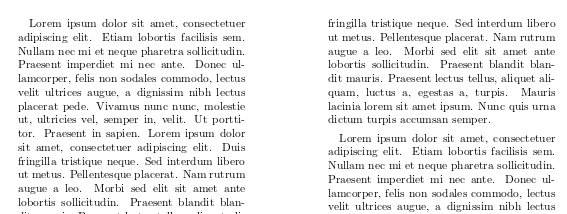Lengths in LaTeX
In LaTeX there are a lot of lengths determining various dimensions of prepared documents. For example, specified dimension parameters characterize fonts, pages, or paragraphs.
Units
Below a description of available units in LaTeX.
| Abbreviation | Value |
|---|---|
| pt | a point is approximately 1/72.27 inch, that means about 0.0138 inch or 0.3515 mm (exactly point is defined as 1/864 of American printer’s foot that is 249/250 of English foot) |
| mm | a millimeter |
| cm | a centimeter |
| in | inch |
| ex | roughly the height of an 'x' (lowercase) in the current font (it depends on the font used) |
| em | roughly the width of an 'M' (uppercase) in the current font (it depends on the font used) |
| mu | math unit equal to 1/18 em, where em is taken from the math symbols family |
| sp | so-called "special points", a low-level unit of measure where 65536sp=1pt |
Below an example that shows the difference between ex and em units.
\documentclass[twocolumn]{article}
\usepackage{blindtext}
\usepackage{graphicx}
\setlength{\columnsep}{1in}
\begin{document}
A width of \texttt{10ex} produces:
\includegraphics[width=10ex]{overleaf-logo}
\vspace{5mm}
A width of \texttt{10em} produces:
\includegraphics[width=10em]{overleaf-logo}
\end{document}

Lengths
Lengths are units of distance relative to some document elements. Lengths can be changed by the command:
\setlength{\lengthname}{value_in_specified_unit}
For example, in a two-column document the column separation can be set to 1 inch by:
\setlength{\columnsep}{1in}

Below is a table with some of the most common lengths and their description
| Length | Description |
|---|---|
\baselineskip
|
Vertical distance between lines in a paragraph |
\columnsep
|
Distance between columns |
\columnwidth
|
The width of a column |
\evensidemargin
|
Margin of even pages, commonly used in two-sided documents such as books |
\linewidth
|
Width of the line in the current environment. |
\oddsidemargin
|
Margin of odd pages, commonly used in two-sided documents such as books |
\paperwidth
|
Width of the page |
\paperheight
|
Height of the page |
\parindent
|
Paragraph indentation |
\parskip
|
Vertical space between paragraphs |
\tabcolsep
|
Separation between columns in a table (tabular environment) |
\textheight
|
Height of the text area in the page |
\textwidth
|
Width of the text area in the page |
\topmargin
|
Length of the top margin |
Using lengths as units
Default lengths can be set to any desired value up to a maximum of approximately 16384pt (or 5.75 metres), a hard-coded limit built into TeX engines. LaTeX's length parameters can also be used as units to set the dimensions of other LaTeX elements. For instance, you can set an image to have a width of one quarter the total text width:
\includegraphics[width=0.25\textwidth]{overleaf-logo}
[...]

In the command \includegraphics the width is set to 0.25 the width of the entire text area (see Inserting Images for more information about this command). You can use any length and multiply it by any factor.
Further reading
For more information see the article about lengths on wikibooks.
Overleaf guides
- Creating a document in Overleaf
- Uploading a project
- Copying a project
- Creating a project from a template
- Using the Overleaf project menu
- Including images in Overleaf
- Exporting your work from Overleaf
- Working offline in Overleaf
- Using Track Changes in Overleaf
- Using bibliographies in Overleaf
- Sharing your work with others
- Using the History feature
- Debugging Compilation timeout errors
- How-to guides
- Guide to Overleaf’s premium features
LaTeX Basics
- Creating your first LaTeX document
- Choosing a LaTeX Compiler
- Paragraphs and new lines
- Bold, italics and underlining
- Lists
- Errors
Mathematics
- Mathematical expressions
- Subscripts and superscripts
- Brackets and Parentheses
- Matrices
- Fractions and Binomials
- Aligning equations
- Operators
- Spacing in math mode
- Integrals, sums and limits
- Display style in math mode
- List of Greek letters and math symbols
- Mathematical fonts
- Using the Symbol Palette in Overleaf
Figures and tables
- Inserting Images
- Tables
- Positioning Images and Tables
- Lists of Tables and Figures
- Drawing Diagrams Directly in LaTeX
- TikZ package
References and Citations
- Bibliography management with bibtex
- Bibliography management with natbib
- Bibliography management with biblatex
- Bibtex bibliography styles
- Natbib bibliography styles
- Natbib citation styles
- Biblatex bibliography styles
- Biblatex citation styles
Languages
- Multilingual typesetting on Overleaf using polyglossia and fontspec
- Multilingual typesetting on Overleaf using babel and fontspec
- International language support
- Quotations and quotation marks
- Arabic
- Chinese
- French
- German
- Greek
- Italian
- Japanese
- Korean
- Portuguese
- Russian
- Spanish
Document structure
- Sections and chapters
- Table of contents
- Cross referencing sections, equations and floats
- Indices
- Glossaries
- Nomenclatures
- Management in a large project
- Multi-file LaTeX projects
- Hyperlinks
Formatting
- Lengths in LaTeX
- Headers and footers
- Page numbering
- Paragraph formatting
- Line breaks and blank spaces
- Text alignment
- Page size and margins
- Single sided and double sided documents
- Multiple columns
- Counters
- Code listing
- Code Highlighting with minted
- Using colours in LaTeX
- Footnotes
- Margin notes
Fonts
Presentations
Commands
Field specific
- Theorems and proofs
- Chemistry formulae
- Feynman diagrams
- Molecular orbital diagrams
- Chess notation
- Knitting patterns
- CircuiTikz package
- Pgfplots package
- Typesetting exams in LaTeX
- Knitr
- Attribute Value Matrices
Class files
- Understanding packages and class files
- List of packages and class files
- Writing your own package
- Writing your own class